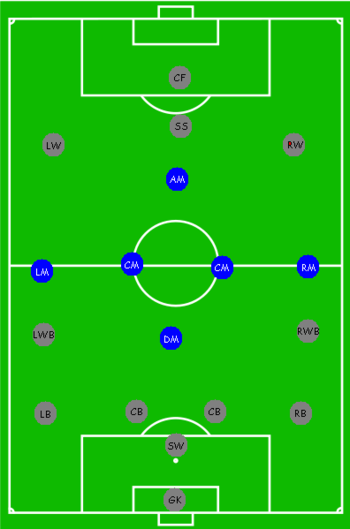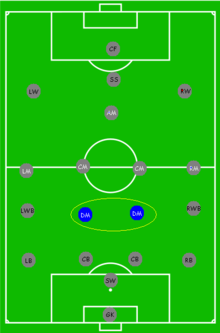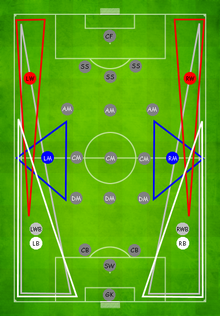Midfielder
For the Australian Rules position, see Midfielder (Australian Rules).

In association football, a midfielder is a player whose position of play is usually midway between the attacking strikers and the defenders (highlighted in blue on the diagram) But as also stated on the diagram, they can also play in between again, as in behind the striker/s or in front of defenders. Their main functions are to dispossess (tackle) the opposing team, to retain possession of the ball, and to feed it to the strikers, and perhaps, to score as well. Some midfielders play a more defensive role, some are there to keep things moving, some are great all round players while others are more advanced/attacking. The number of midfielders a team uses during a match may vary, depending on the team's formation and each individual player's role. The group of midfielders in a team is called the midfield.[1]
More complete/all-round midfielders require a number of skills on top of work-rate/stamina: they can use both defensive and offensive qualities, tackling/marking and shooting/passing during any given match. Most managers field at least one central midfielder with a marked task of breaking up opposition's attacks while the rest are usually more adept to creating goals or have equal responsibilities between attack and defence. At either side of the pitch a manager can field a right or left midfielder, or what is called a winger, a specialist side midfielder usually used for attack but are more often than not, especially in more recent times, expected to help with defensive duties also.
In essence, a good midfield must possess the ability to be combative whilst also being creative. A good striker without midfield support could lack attacking chances, while a defence likewise could be severely tested. Because they occupy the most influential parts of the pitch, midfielders are perhaps more likely to influence the outcome of a match than other positions, especially if they have vision for a good pass or ability to score. You could still have a good midfield without a mixture of the above and be successful/create chances, but the team would need to rely on other players/ways to help attack/defend.
Midfielders typically exhaust the most energy during a match due to the distance they cover on a pitch, as at times they can be called back into defence, or required to attack with the strikers.
Defensive midfielder

A defensive midfielder or a holding midfielder is a central midfielder who is usually stationed in front of the back defenders for defensive reasons, thus "holding back" the freedom of the opponents to attack, but can also play in a flat 4 4 2 or other formations/positions and drop back/hold position when needed. This specialist midfielders main responsibilities are usually to defend against or tackle the opposing team and hold his defensive position, safely distributing the retrieved ball to more attack-minded players. Because some have good passing or sometimes even good shooting ability though, they can sometimes be seen further up the field and even score a goal, especially against weaker opposition when there is far less emphasis on defending. Defensive midfielders can also play on either side of the midfield as-well, like we see with Gennaro Gattuso of Milan at times, depending on how the manager sets his team up. The latter mentioned usually when attacking from the middle and/or the opposite flank or equally when playing the long ball game. Some central midfielders also play from the defensive midfield position, mainly the play-maker type to have more time on the ball and thus use their great passing ability to help with attacks just as much as when further up the field.
The defensive midfield position in front of the defenders is quite new, as years ago it was more rigid 4 4 2's that were often used, until years ago still, when they started experimenting and thus creating some of the best formations we see today.
The defensive midfielder position is also referred to in Brazilian Portuguese as "volante" and in South American Spanish as "volante de marca" (Spanish & Portuguese for "Rudder" or someone who gives direction), and in Portugal as a "trinco" (meaning "lock"). Most Brazilian teams deploy at least one "volante" in their team, including the Brazilian national team who have fielded defensive midfielders, such as 1994 World Cup winning team captain Dunga.
Accomplished defensive midfielders playing today include Claude Makélélé, Gennaro Gattuso, Owen Hargreaves and Javier Mascherano.
The term "box to box" player (see below) is often used to refer to more dynamic defensive midfielders.
Central midfielders
Central midfielders play several roles on the field of play but are usually the more play-maker or all-round type of player, and are usually very important for either attacking duties or both attacking/defensive duties alike, so can be one of the most important positions on the field. However, different tactics make it possible to not need nor have them on the field, so it's not always the case. Their position enables them to have an all-round view of the match, and as most of the action takes place in and around their area of the pitch, central midfielders often exert the greatest degree of control over how a match is played. There is obvious exceptions however, mainly when, like stated above, they don't play, when it's a tight match and no midfielders have any real influence in the game, a striker defender or keeper has been obviously far more influential or even when a match is decided by a very poor performance or a mistake. These players can also be important even when not touching the ball, namely when the manager plays the long ball game and can sometimes miss the whole midfield. They would still be very important for any success, but it's mainly just their positional play and stamina/work-rate that's needed in this scenario and/or sometimes a little/lot of defending, depending on how well the tactics work.
Some players prefer to set up an attack from a withdrawn position, and are often coined deep-lying play-makers, mainly because of their ability to spread play and dictate the game from a withdrawn position. Due to some midfield players weaknesses in their defensive aspects, they are sometimes supported by holding midfielders, but at times can play just as well without one. At this moment in time, some of the more well known central midfielders include, but are not limited to, Michael Carrick, Andrea Pirlo, Daniele De Rossi, John Obi Mikel. Some can also do some things better than others, so can have a far greater influence, only seem to have a far greater influence, or even seem to be completely different players, when a lot are very similar or do similar jobs, just have some different attributes so can be used for different things at different times. Some are only fairly good at some things and not great at any, and these players are mainly there to keep the ball moving and/or closing down the opposition/spaces more than anything else.
"Box-to-box" midfielders
Box-to-box' players can provide the link between defence and attack and can score and defend at either ends of the field.[2] The more rounded/complete players, they typically possess exceptional stamina and are usually equally adept at both defensive and offensive duties alike.
Notable examples include Roy Keane, Michael Ballack, Patrick Viera, Steven Gerrard, and Michael Essien, all capable of scoring and defending from "box to box". This section of the field is often known as a team's "engine room", and it's usually because these types of players are all over the park and don't seem to stop, but it can also be used for defensive midfielders when doing most of a teams chasing/tackling both with a box-to-box player next to him or when there is no box-to-box player on the field.
Some box-to-box players are far more of a defensive midfielder naturally, but because of good ability on the ball and their usually fantastic work-rate/stamina, coupled with playing for the better teams and thus less defending needs doing, they can advance far more than against teams of similar/better quality and therefore only seem like a box-to-box player, but if they play for the weaker of the two or if the teams are more level, then you are far less likely to see them advance very often.
Attacking midfielder/Deep lying forward

An attacking midfielder/forward is any midfielder/forward who is stationed in a more advanced midfield/forward position to assist goalscoring, but can also start out a lot deeper/more advanced and advance/retreat when the chance/needs arrive.
The attacking midfielder/deep lying forward is an influential position and usually requires the player to possess good technical abilities such as, but not limited to, good passing ability, shooting, dribbling skills, good movement and/or positional play. The attacking midfielder can be similar to some play-maker roles. Some are deeper playing attacking midfielders though that like to arrive late in the box, and as such, usually have other good attributes/skills, such as heading, like Everton's Tim Cahill. Some can also be more advanced, usually a forward and great work ethic means they can do or seem to do several jobs at once almost, like Wayne Rooney sometimes seems to, and be far deeper at times. They don't always have good passing ability, and these are the one's less likely to be termed play-maker.
He is usually the offensive pivot of the team and is mostly used from a more centralised position, sometimes known in football as "playing in the hole", although this term can also be used to describe a deep-lying forward. This midfielders/forwards role is used to create goal-scoring opportunities for his own team and/or score himself, but can also be used to help stop the oppositions deep lying play-maker/defensive midfielder from having too much time on the ball.
Francesco Totti, Rafael van der Vaart, Juan Roman Riquelme, Kaká, Wayne Rooney, Lionel Messi, Diego and Carlos Tevez are attacking midfielders or forwards that sometimes play in this position and are widely considered to be among the best in the world at the moment, but because of their ability, can play in other positions also, and often do so.
Winger

A winger is a midfielder who is stationed in a wide position near the touchlines.[3] Wingers such as Stanley Matthews or Jimmy Johnstone used to be classified as forwards in traditional W-shaped formations, and were formally known as "Outside Right" or "Outside Left," but as tactics evolved through the last 40 years, wingers have dropped to deeper field positions. Wingers are now classified as part of the midfield, usually in 4-4-2 or 4-5-1 formations (but whilst the team is on the attack, they tend to resemble 4-2-4 and 4-3-3 formations respectively).
It is a winger's duty to beat opposing fullbacks/wingbacks and to deliver cut-backs or crosses from wide positions or even cut inside to do the same and/or score. They are usually some of the quickest players in the team and usually have very good dribbling skills as well, as they are mainly attacking players. Today, some of the best examples are Cristiano Ronaldo, Simao Sabrosa, Robinho, Franck Ribery, and Ryan Giggs.
Traditionally wingers were purely attacking players who hugged the touch line and were not expected to track back and defend. This began to change around the time of the 1966 World Cup, when England manager Alf Ramsey led a team without natural wingers to the championship. This team was known as the "Wingless Wonders".
This has led to most modern wingers having a more demanding role in the sense that they are expected to defend and track back to repossess the ball, as well as provide skillful crosses for centre forwards and strikers. Sometimes, they are also expected to cover/attack the central area, as well as switch flanks. Technically gifted wingers are able to dribble infield, and by means of using a plethora of tricks, pass defenders and shoot or set up a teammate.
